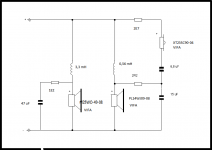it looks like you have crossover freq at 650 Hz, and also a rising distortion at the same frequency.
Any thoughts?
They look quite typical - not much else to say. In room measurements are always hard to interpret.
it looks like you have crossover freq at 650 Hz, and also a rising distortion at the same frequency.
The % THD rises because the response has fallen - again, quite typical.
Cross over
This is the serial cross over setup with Vifa drivers.
Drivers are:
Vifa woofer P25WO
Vifa Premium midwoofer PL14WJ09
Vifa XT tweeter XT25SC90
Thanks for your replies!
This is the serial cross over setup with Vifa drivers.
Drivers are:
Vifa woofer P25WO
Vifa Premium midwoofer PL14WJ09
Vifa XT tweeter XT25SC90
Thanks for your replies!
Attachments
OK guys I want to use this for a car application, I just download the program. Do i need a loop back for measuring accurate impulse response? I want to use this to improve time alignment and phase
no loop back needed.
to check timing you need to lock the time (2nd tab) after you've done one measurement.
to check timing you need to lock the time (2nd tab) after you've done one measurement.
A few questions about holmimpulse and DRC in general:
1) Does it attempt to reduce distortion?
2) Is it a good idea to average a few positions (L, R, and center) to create filters?
1) Does it attempt to reduce distortion?
2) Is it a good idea to average a few positions (L, R, and center) to create filters?
1) No distortion reduction, its all linear
2) It depends on what you are looking for. If the measurement is steady state then multiple points have to be done to get reasonable results. If you are looking at the direct sound then one point is fine.
2) It depends on what you are looking for. If the measurement is steady state then multiple points have to be done to get reasonable results. If you are looking at the direct sound then one point is fine.
Yeah, I figured it wouldn't mess with distortion. Could you elaborate a bit on point 2? I am not quite sure what you mean by steady state vs direct sound.
If you're measuring in a room, you can window the measurement to show only the direct sound (sound coming directly from the speaker to the mic, not including any reflections from the surfaces of the room). In typical rooms you will only be able to measure high frequencies without including the influence of the room. If you make your window longer, your measurement will include the effect of the room. I would actually suggest that it can be beneficial to look at multiple points in either case, or if you're in an anechoic chamber or measuring outside. Instead of eq'ing the speaker at a single point which may or may not have something weird going on, try to measure over an area so when you're listening the speaker is producing the response you want (more or less) over that area. Or you might find that your speaker is very well behaved over some reasonable area in front of it and eq'ing at one point will work well over a decent sized area.
Steady state vs. direct sound are fairly fundamental room acoustics principles that you should be able to look up on the web. Sorry for not answering your question, but it would be a very long response that I am sure could be found elsewhere if you looked.
Hi guys, thanks for the help a while back. I have been using this for car and it works great. I do have a question though, when it comes to phase how should I tackle that? Should I try to get all the speakers as close to zero as possible or all speakers as close as possible to the same phase? what do you suggest. It is a car so speakers are kinda all over the place at times when it comes to phase. I appreciate any feedback thanks
Sorry I should say more about the equipment I am using. I am using a three way setup, tweeter, mid and midbass. I have a dsp with a lot of control in time and phase. I was told when doing measurements to have crossovers off and to do measurements with mid and midbass with start freq at 20hz and go up to 1k for tweeters. Now I was thinking you would want the crossover along with the slope on. But any advice or ideas would be great, thanks.
I would suggest that it is the fact that % uses the fundamental level as a reference. This reference is falling creating a greater % even if the level of the harmonics is also falling.
So, are you saying those HD curves are pretty much worthless because of the use of the fundamental? What is the true HD then?
I would definitely say that any use of HD is pretty much worthless, but that was not my point. Being referenced to the fundamental any change in the HD with frequency should be normalized to a common reference level.
I'm sorry to ask a very silly question, but where is there any information about how to actually make a measurement. I suppose the program generates an impulse that needs amplifying to feed the DUT, and a microphone to catch the acoustic output.
Where can I find instructions about this, please?
Where can I find instructions about this, please?
- Home
- Design & Build
- Software Tools
- HOLMImpulse: Measurements in practice
